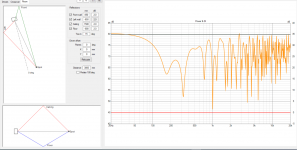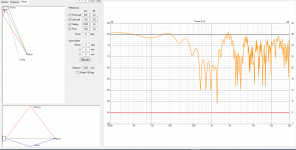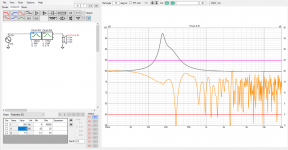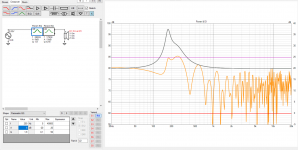There are certainly differences, but the main issue for me is whether these would be audible, or have minor impact. The Elsinore statements do not impress me at all.
I am all open for publications that conclusively demonstrate I am wrong.
My main point is that all sorts of magic is attributed to specific drivers (or components for that matter: (a Duelund 5 mH coil for some 900 US$), much of which is only between the ears. And yes, I have immense admiration for Purify and Lars R. Whether it all sounds better is mainly system and application dependant in my book.
I am all open for publications that conclusively demonstrate I am wrong.
My main point is that all sorts of magic is attributed to specific drivers (or components for that matter: (a Duelund 5 mH coil for some 900 US$), much of which is only between the ears. And yes, I have immense admiration for Purify and Lars R. Whether it all sounds better is mainly system and application dependant in my book.
Yes of course, this is also something I've just learned about so have no idea about audibility and its relative impact. Sticked out as something that could make speakers (drivers) sound different in same application even though they were band passed and not operating on their limits.
Sorry I have no papers on this, but would be interested as well. I think this is something I need to study next, how passive networks affect this kind of stuff.
Here is Purifi blog post that kind of goes through in high level some of how driver can address the stuff https://purifi-audio.com/2021/10/14/some-speaker-problems-that-needed-solving/
Yes I'm bit confused about all this but here is what I'm thinkin of it: various drivers have different aspects on them that produce these non linear effects, motor and mechanical parts that vary properties with excursion. Typically outcome is just lumped under THD number as I've understand it. But then, it is possible to manipulate, or somewhat mitigate, some of the electrical effects at least, with crossover parts so its all related, performance depends on application and other aspects of a system how the driver itself relates to everything else. While reducing excursion would reduce all kinds of non-linear distortions also damping of the driver and how amplifier + driver combination works seems to affect combined performance, in application. I mean if one has certain requirements for say a mid woofer, so and so sensitivity, bandwidth, SPL capability and basic stuff like this, its possible to choose few drivers that fit the bill but have bit different responses and thus require bit different crossover on them, which in turn affect the performance. I mean some driver that is better than others for some particular use case, might not be as good for another just because different crossover topology, or amplifier. Again, not sure what the magnitude of such differences are, meaningful or not, but nevertheless something that might effect results of comparisons. Drivers performance is application dependent as you say, I think. Well, I guess with some work one can make best out of any system with reasonable components chosen for it and go around this issue. At worst, there is some bad sound, even though frequency responses for both would be roughly similar.
Well, getting out of topic somewhat 😀
Sorry I have no papers on this, but would be interested as well. I think this is something I need to study next, how passive networks affect this kind of stuff.
Here is Purifi blog post that kind of goes through in high level some of how driver can address the stuff https://purifi-audio.com/2021/10/14/some-speaker-problems-that-needed-solving/
Yes I'm bit confused about all this but here is what I'm thinkin of it: various drivers have different aspects on them that produce these non linear effects, motor and mechanical parts that vary properties with excursion. Typically outcome is just lumped under THD number as I've understand it. But then, it is possible to manipulate, or somewhat mitigate, some of the electrical effects at least, with crossover parts so its all related, performance depends on application and other aspects of a system how the driver itself relates to everything else. While reducing excursion would reduce all kinds of non-linear distortions also damping of the driver and how amplifier + driver combination works seems to affect combined performance, in application. I mean if one has certain requirements for say a mid woofer, so and so sensitivity, bandwidth, SPL capability and basic stuff like this, its possible to choose few drivers that fit the bill but have bit different responses and thus require bit different crossover on them, which in turn affect the performance. I mean some driver that is better than others for some particular use case, might not be as good for another just because different crossover topology, or amplifier. Again, not sure what the magnitude of such differences are, meaningful or not, but nevertheless something that might effect results of comparisons. Drivers performance is application dependent as you say, I think. Well, I guess with some work one can make best out of any system with reasonable components chosen for it and go around this issue. At worst, there is some bad sound, even though frequency responses for both would be roughly similar.
Well, getting out of topic somewhat 😀
Last edited:
Cab or not, I liked that little warmth in its presentation. These Barcelona's were tucked into the corners. Eventually he replaced the Altecs with a pair of upper class Kef's, placed in another room. They could play loud, but didn't do the same for me. I remember one evening with the Altecs when they had a party next door (we lived under the same roof) it sounded like they were playing live next door! He had a couple of subs for the bottom end, but all I remember liking is the voices. That's what I wanted, that's what I've got.While the 411A was a wonderful performing wide range woofer, it's at ~160 deg (theoretical 180 deg) out to ~800 Hz/15", so the 'warmth' is as much or more due to the cab than the driver based on comparison testing at the Altec S.E. distributor with the Barcelona Vs its 9846 studio monitor and my own comparisons with other various size speakers before them when folks started wanting me to downsize my typical pioneer's big/huge cabs to fit in dorm rooms and new, smaller apartments, yet keep their performance. Sound familiar? 🙂
In short, IME, if not wall/corner loaded, cabs need to be large enough to cover down to the driver's LF mass corner (Fhm = ~2*Fs/Qts') as part of the requirements to get a ~ 'feel'/'warmth'/'fullness' of a live performance within the obvious room, reproduction limitations.
While the 411A was a wonderful performing wide range woofer, it's at ~160 deg (theoretical 180 deg) out to ~800 Hz/15", so the 'warmth' is as much or more due to the cab than the driver based on comparison testing at the Altec S.E. distributor with the Barcelona Vs its 9846 studio monitor and my own comparisons with other various size speakers before them when folks started wanting me to downsize my typical pioneer's big/huge cabs to fit in dorm rooms and new, smaller apartments, yet keep their performance. Sound familiar? 🙂
In short, IME, if not wall/corner loaded, cabs need to be large enough to cover down to the driver's LF mass corner (Fhm = ~2*Fs/Qts') as part of the requirements to get a ~ 'feel'/'warmth'/'fullness' of a live performance within the obvious room, reproduction limitations.
Trying to figure out where the perceived warmth comes from, if assuming anechoic frequency response stays the same (optimal, what ever that is) between small and large cabinet, thinking that only cabinet size changes and it leads to warm sound. Is it correct to assume perception of warmth in case of bigger enclosure is related to interaction with room boundaries? big cabinet has less output (to lower frequency) towards room boundary behind and has apparently more of the warmth frequencies at listening position because there is now less destructive interference? Even better there might be constructive interference instead if tucked close enough to boundary / multiple boundaries.
This is important nugget of information I think. If two systems have identical (anechoic) response they won't sound the same unless positioned the same way in a room and radiate around the same. Jolly memory of good sound in an occasion somewhere (party, friends place, hifi shop) might not have much to do what the speaker response is and everything to do how the speaker interacted with the room, and this is something no EQ will fix 🙂
edit. small thought experiment: if this is the case then we can have small or big enclosure with same perceived warmth/fullness, as long as its close enough to boundaries so that effectively similar interaction with room happens. I mean small but flat enclosure could be very close to wall, in other words have no destructive interference on warmth frequencies stay intact, not destroyed by interference. If box is big, so that it does not fit close enough to a wall and it needs the width / bigness to do the job of a wall for the warmth frequencies, prevent destructive interference.
Last edited:
and this is something no EQ will fix 🙂
Not sure I agree with that part. How far do you want to go? I rob my room of first reflections with damping panels, only to give back a virtual impression of another space with ambience speakers. Due to this trickery, my room sounds different from what it is. It sounds larger than it's real dimensions.
As the impressions of another space are from a synthesized space, it adapts to the music. (a touch of random hall reverb from Lexicon, by David Griesinger)
Listening to the music you wouldn't know the ambient speakers are playing, until they are turned off. The key is not to attract attention to themselves, but to enhance what happens in front from the main speakers. As I said: My-Fi, not Hi-Fi. Mostly done with EQ though, and a few (rather large) absorbing panels.
My inspiration: member werewolf/Lycan on the DIYMobileAudio forums and the many papers from David Griesinger.
So I don't just mimic other speakers, as that wasn't my intention, but I do mimic another space. All I wanted from that Altec sound was it's warmth in the lower midrange. One can do a lot, especially if one is willing to manipulate and work with the space you're in.
Last edited:
Yeah I should have written "EQ alone" 🙂 You have speakers that have great rejection toward vertical reflections, some treatment on lateral ones including having the speakers very close to side boundary if I remember correctly form some photos. I bet these do most of the work, optimized interference for the warmth frequencies, and then some EQ to tune it up some. You didn't copy your ideal, but made your own system towards it instead by working on multiple things that together make the impression. Why would you have any of these tweaks in the system if mere EQ was able to replace it all?
Of course we need to what we have to do to make good sound, what is it that we are after. Topic of the thread, duplicating sound, EQ, DSP, will definitely help any system to reach any target but copying response of another system doesn't work out too good unless the acoustics were also copied, physical speaker and boundaries 😉 Anyway, I see no point copying some other system response as such, just work out the one you (any of you) have, as you have, to have similar perceived sound in your situation 🙂 Duplicate perceived sound by adjusting the environment and system so that acoustics support the target, adjust output of the system which EQ is part of, what ever works out towards the target. Ok I'm drifting already, I think we are about on the same page with the subject, coffee break over, carry on.
Of course we need to what we have to do to make good sound, what is it that we are after. Topic of the thread, duplicating sound, EQ, DSP, will definitely help any system to reach any target but copying response of another system doesn't work out too good unless the acoustics were also copied, physical speaker and boundaries 😉 Anyway, I see no point copying some other system response as such, just work out the one you (any of you) have, as you have, to have similar perceived sound in your situation 🙂 Duplicate perceived sound by adjusting the environment and system so that acoustics support the target, adjust output of the system which EQ is part of, what ever works out towards the target. Ok I'm drifting already, I think we are about on the same page with the subject, coffee break over, carry on.
Last edited:
Eh quick second thoughts on what I've just wrote: perceived warmth or fullness could be anything I guess, for example lack of distortion, in other words serious SPL capability. Big speakers are generally more capable than small ones in this regard. Could be just the target response, along with directivity suitable for it when in room, nice smooth tilt for example, something along what wesayso already posted early on. Alright, I think people have already covered this kind of stuff for the most part so... anyway, its fun time thinking about what affects what 🙂
edit.
Here is what motivated to post about warmth / relation to boundaries. Its extremely difficult to have as system and then position it so that the whole low mid range is not gone due to boundary interference. This is simulation of ideal point source (omni of course) near one room corner showing some bad interference, flat anechoic frequency response (black) but the whole low midrange is down significantly (orange). Basically the low mids come back only when the source is near boundaries (small speaker), or limits sound towards boundaries (big speaker) so that less of destructive interference happens, or both. Due to physical size of speakers and rooms practical speaker positions tend to accumulate all dips on the low mids, say 150Hz - 1kHz is quite bad no matter what. This is someting EQ does not fix, only building speaker with acoustic output suitable for position it has would.


For completeness here is the first above, with some boost EQ added to fill in some of the lost low mids. Then with changing refrence angle a bit, moving a bit in the room, and now the response is wonky again. Point being EQ can't fix issues that depend on location, like position of speaker related to boundary.


edit.
Here is what motivated to post about warmth / relation to boundaries. Its extremely difficult to have as system and then position it so that the whole low mid range is not gone due to boundary interference. This is simulation of ideal point source (omni of course) near one room corner showing some bad interference, flat anechoic frequency response (black) but the whole low midrange is down significantly (orange). Basically the low mids come back only when the source is near boundaries (small speaker), or limits sound towards boundaries (big speaker) so that less of destructive interference happens, or both. Due to physical size of speakers and rooms practical speaker positions tend to accumulate all dips on the low mids, say 150Hz - 1kHz is quite bad no matter what. This is someting EQ does not fix, only building speaker with acoustic output suitable for position it has would.


For completeness here is the first above, with some boost EQ added to fill in some of the lost low mids. Then with changing refrence angle a bit, moving a bit in the room, and now the response is wonky again. Point being EQ can't fix issues that depend on location, like position of speaker related to boundary.


Last edited:
I'd say: experiment! That's what I do to find out what I like. Not all experiments work out equally well though. Armed with measurement tools I've done almost all I could think of.
- Home
- Loudspeakers
- Multi-Way
- Bob Carver ”Transfer function duplication” applied to Loudspeakers with DSP?